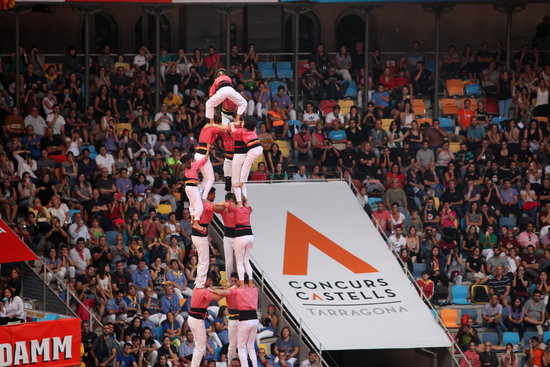Vella de Valls, winner of Tarragona human tower competition
In second place come 'colla' groups Vilafranca, Jove de Tarragona in third, and Mataró in fourth

The Colla Vella dels Xiquets de Valls won first place in the 27th edition of the Tarragona Castells Competition.
Known as the Vella de Valls, the group won with a total of 9,690 points which they earned with complex constructions and towers.
The Vella de Valls dethrones the Castellers de Vilafranca 'colla' (the sport's word for team) which has held the crowning position for the last eight editions, and which now came in second.
For their part, the Castellers de Vilafranca (known as the 'verds' for the green color of their uniform) earned 8,070 points.
A time-tested tradition
The human towers competition that every two years pits the best groups in the country against each other will see 42 teams competing to build the tallest and most complex constructions.
Over the weekend, the different groups competed for top spot in Tarragona's TàrracoArena Plaça, with the best 12 competing in the finals on Sunday before an audience of some 25,000 people. In fact, this edition is the first to completely sell out.
Proclaimed a Masterpiece of the Oral and Intangible Heritage of Humanity by UNESCO in 2010, this weekend in Tarragona has featured the very best examples of the tradition of building human towers, and an ideal opportunity for anyone interested in seeing what the tradition that goes back to the 17th century is all about.
How the towers are scored
While each team will have their own particular strategies and structure, the towers are scored on the number of tiers in each tower and the number of people on each level. A tower is complete once a child, sometimes as young as five, known as an ‘enxaneta,’ reaches the top and raises their arm.
While each colla can be distinguished by the color of their shirts, all the castellers wear the traditional garb that includes white trousers and a wide black sash wrapped around the waist, providing not only back support but also a foothold for the participants making the perilous climb up –or down– the tower of people.
Human safety net
Building a human tower is not easy, and each group practices for months before competing. Yet, even though it is not unusual to see a human tower come crashing down, the castellers have their own human safety net, in the form of dozens of team members supporting the base of the tower.
In fact, this element has even given Catalan one of its most unique expressions, ‘fer pinya,’ which when used figuratively means to come together in strong support of someone, or something, in the face of adversity.